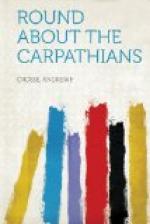We arrived at Karansebes in the afternoon, and by good-luck it chanced to be fair-day. This is a central market for a considerable extent of country, so that there is always a great gathering of people. In driving into the town we passed a long bridge which crosses a low-lying meadow, the central arch being sufficient to span the stream, at least in summer. From this elevation we had a capital view of the fair, which was being held in these meadows, and could look down leisurely on the whole scene; and a very novel and amusing sight it was.
There were hundreds of people; and what a variety of races and diversity of costumes! The Wallack women, in their holiday suits, were the most picturesque. Many of them were handsome, and they have generally a very superior air to the men; they are better dressed and more civilised looking. There were a sprinkling of Magyars in braided coats, or with white felt cloaks richly embroidered in divers colours. But the blue-eyed, fair-complexioned German was far more numerous. The Magyar element is very much in the minority in this particular part of Hungary. The Jews and the gipsies were there in great numbers—they always are at fairs—in the quality of horse-dealers and vendors of wooden articles for the kitchen. The Jew is easily distinguished by his black corkscrew ringlets, and his brown dressing-gown coat reaching to his heels. This ancient garment suits him “down to the ground;” in fact his yellow visage and greasy hat would not easily match with anything more cleanly. These Jewish frequenters of fairs are, as a rule, of the lowest class, hailing either from the Marmaros Mountains in North-Eastern Hungary, or from Galicia.
The fair is really a very important exhibition of the products and manufactures of the country, and it is well worth the attention of the stranger, who may pass on with the motley crowd through streets of stalls and booths. One annexe is devoted to furniture, from a winged wardrobe down to a wooden spoon. In another part you see piles of Servian rugs, coarse carpets, sheepskin bundas, hairy caps of a strange peaked form, broad hats made of reed or rush, and the delightful white felt garments before mentioned, which are always embroidered with great taste and skill. Horses, cows, and pigs are also brought here in great numbers to exchange owners. The long-horned cattle are perhaps the most striking feature in the whole fair. They are white, with a little grey on the necks, flanks, and buttocks. Oxen are much used for hauling purposes as well as for the plough. A pair of oxen, it is considered, will do the work of four horses.
Professor Wrightson says: “The Podolian is an aboriginal race, descended from the wild urox (Bos primigenius). The race is remarkable for its capability of resisting influences of climate, and its contentedness with poor diet.... The Hungarian oxen are considered by naturalists as the best living representative of the original progenitors of our domestic cattle.” Of the buffalo the same writer says: “It was introduced into Hungary by Attila; it is found in the lowlands, on both sides of the Danube and the Theiss, Lower Hungary, and Transylvania. In 1870 there were upwards of 58,000 in Transylvania, and more than 14,000 in Hungary."[10]




